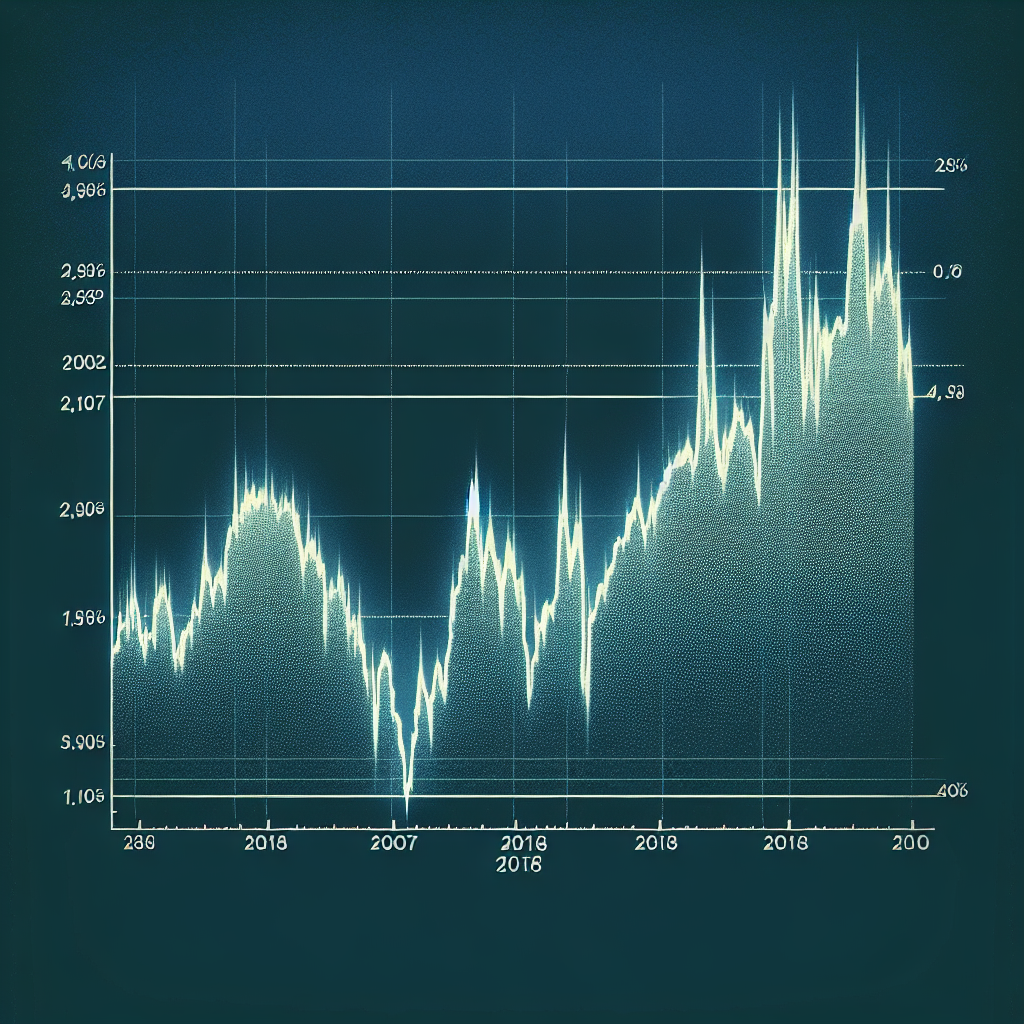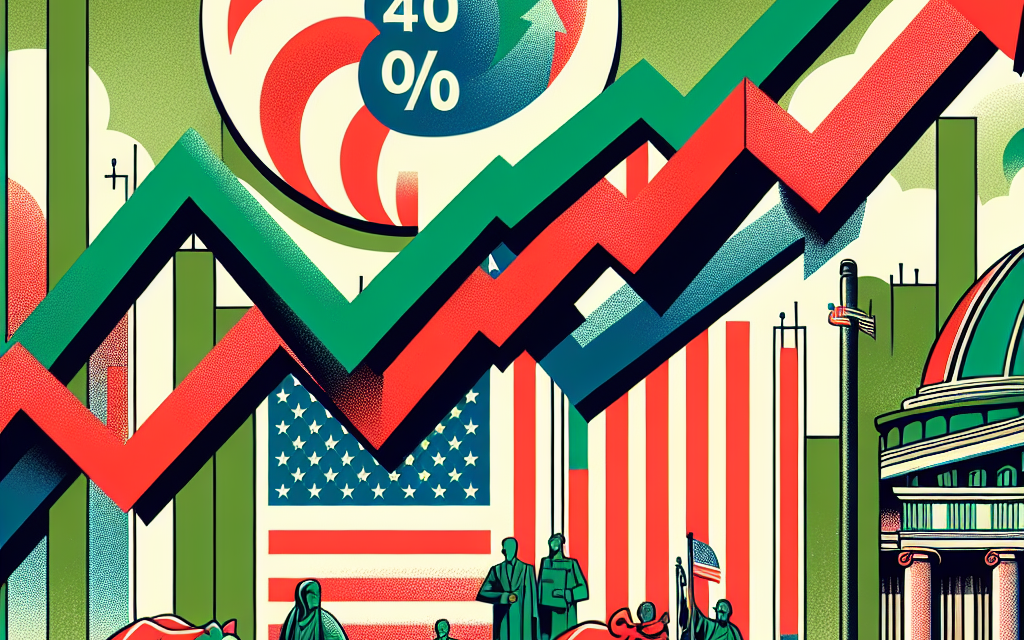“US Stocks: Navigating the Halfway Mark of Post-Election Momentum”
Introduction
Following the significant rally in U.S. stock markets that occurred in the wake of the recent presidential election, a notable retracement has been observed, with stocks giving back approximately half of their post-election gains. This development comes amid a complex interplay of factors influencing investor sentiment, including economic data releases, shifts in monetary policy expectations, and geopolitical uncertainties. The initial surge was driven by optimism surrounding potential policy changes and economic stimulus measures promised by the new administration. However, as the market digests these developments, concerns over inflation, interest rate hikes, and global economic challenges have contributed to increased volatility and a pullback in stock prices. This retracement highlights the dynamic nature of financial markets and the ongoing reassessment by investors of the economic landscape and its implications for future growth and corporate earnings.
Analysis Of The US Stock Market’s Post-Election Surge And Subsequent Retracement
In the aftermath of the recent U.S. elections, the stock market experienced a notable surge, driven by investor optimism and expectations of favorable economic policies. However, this initial exuberance has been tempered by a subsequent retracement, with U.S. stocks giving back approximately half of their post-election gains. This development warrants a closer examination of the factors contributing to both the initial surge and the subsequent pullback, as well as the broader implications for investors and the economy.
Initially, the post-election surge in U.S. stocks was fueled by a confluence of factors. Investors were buoyed by the prospect of political stability and the potential for new fiscal policies aimed at stimulating economic growth. The anticipation of increased government spending on infrastructure, coupled with potential tax reforms, created a sense of optimism about future corporate earnings. Additionally, the resolution of electoral uncertainty provided a clearer path forward, encouraging market participants to reallocate capital into equities.
However, as the initial euphoria began to wane, several factors contributed to the retracement of these gains. One significant element was the realization that the implementation of new policies might face delays or modifications as they navigate the legislative process. This introduced a degree of uncertainty, prompting investors to reassess their positions. Furthermore, concerns about inflationary pressures and the potential for interest rate hikes by the Federal Reserve added to the cautious sentiment. As inflation indicators showed signs of acceleration, market participants grew wary of the impact on corporate profit margins and consumer spending.
Moreover, global economic conditions played a role in the retracement of U.S. stock gains. The interconnectedness of global markets means that developments abroad can influence domestic equities. For instance, geopolitical tensions and economic slowdowns in key regions can create ripple effects that dampen investor confidence. In this context, the resurgence of COVID-19 cases in certain parts of the world and the accompanying restrictions on economic activity have raised concerns about the pace of global recovery.
In addition to these macroeconomic factors, sector-specific dynamics also contributed to the retracement. Technology stocks, which had been significant drivers of the post-election rally, faced headwinds as valuations came under scrutiny. The rotation from growth-oriented sectors to value-oriented ones reflected a broader shift in investor sentiment, as market participants sought to balance risk and reward in an evolving economic landscape.
Despite the retracement, it is important to recognize that the U.S. stock market remains resilient. The underlying fundamentals of many companies continue to be strong, supported by robust earnings reports and strategic adaptations to changing market conditions. Furthermore, the ongoing vaccination efforts and gradual reopening of economies provide a foundation for sustained recovery.
In conclusion, the retracement of U.S. stock gains following the post-election surge underscores the complex interplay of factors influencing market dynamics. While initial optimism was driven by expectations of favorable policy changes and economic growth, subsequent developments introduced caution and recalibration. Investors must navigate this landscape with a keen awareness of both domestic and global influences, balancing short-term volatility with long-term opportunities. As the market continues to evolve, staying informed and adaptable will be crucial for those seeking to capitalize on the ever-changing investment environment.
Factors Contributing To The US Stock Market’s Recent Volatility
The recent volatility in the US stock market has been a topic of significant discussion among investors and analysts alike. This turbulence has led to the retracement of half of the gains that were achieved during the post-election surge. Several factors have contributed to this recent instability, each playing a crucial role in shaping the current market landscape. Understanding these elements is essential for investors seeking to navigate the complexities of the financial markets.
To begin with, economic indicators have been sending mixed signals, creating uncertainty about the future trajectory of the economy. Inflation rates have been a primary concern, as they have remained persistently high, prompting fears of potential interest rate hikes by the Federal Reserve. Such increases in interest rates could dampen economic growth by making borrowing more expensive for both consumers and businesses. Consequently, this has led to apprehension among investors, who are wary of the potential impact on corporate profits and consumer spending.
In addition to inflationary pressures, geopolitical tensions have also played a significant role in the recent market volatility. The ongoing conflicts and diplomatic standoffs in various parts of the world have heightened uncertainty, leading to fluctuations in commodity prices and impacting global supply chains. For instance, disruptions in the supply of essential goods and raw materials have led to increased production costs for companies, which in turn affects their profitability and stock valuations. As a result, investors have been cautious, leading to increased market volatility.
Moreover, the resurgence of COVID-19 cases in certain regions has added another layer of complexity to the market dynamics. The pandemic continues to pose a threat to global economic recovery, with new variants emerging and causing disruptions in various sectors. This has led to renewed concerns about potential lockdowns and restrictions, which could hinder economic activity and affect corporate earnings. Consequently, investors have been closely monitoring public health developments, as any negative news could trigger further market fluctuations.
Furthermore, the recent volatility can also be attributed to changes in investor sentiment and behavior. The rise of retail investors, facilitated by online trading platforms, has introduced a new dynamic to the stock market. These investors, often driven by social media trends and speculative behavior, can cause rapid price movements in certain stocks, contributing to overall market instability. This phenomenon has been observed in the form of short squeezes and meme stock rallies, which have added to the unpredictability of the market.
In light of these factors, it is evident that the US stock market’s recent volatility is the result of a confluence of economic, geopolitical, and behavioral influences. Investors are faced with the challenge of navigating this uncertain environment, requiring them to remain vigilant and adaptable. As the market continues to respond to these various pressures, it is crucial for investors to stay informed and consider a diversified approach to their portfolios. By doing so, they can better manage risk and potentially capitalize on opportunities that may arise amidst the volatility.
In conclusion, the retracement of gains in the US stock market following the post-election surge underscores the complex interplay of factors contributing to its recent volatility. Economic indicators, geopolitical tensions, pandemic-related uncertainties, and changes in investor behavior all play a role in shaping the current market environment. As these elements continue to evolve, investors must remain attentive and strategic in their decision-making to navigate the challenges and opportunities that lie ahead.
Historical Comparisons: US Stock Market Retracements After Major Political Events
In the wake of significant political events, the US stock market often experiences notable fluctuations, reflecting investor sentiment and economic forecasts. The post-election surge following the recent US presidential election was no exception, as stocks rallied in response to anticipated policy changes and economic optimism. However, as is often the case in the volatile world of finance, this initial exuberance has been tempered by a retracement, with US stocks now having given back approximately half of their gains from the post-election surge. This phenomenon is not unprecedented; historical comparisons reveal that retracements of this nature are a common occurrence following major political events.
To understand the current market dynamics, it is essential to examine past instances where political shifts have influenced stock market behavior. For example, the aftermath of the 2008 presidential election saw a similar pattern. Initially, markets responded positively to the election of a new administration, buoyed by expectations of economic recovery measures. However, as the realities of implementing policy changes set in, the market experienced a retracement, reflecting a more cautious investor outlook. This pattern underscores the tendency of markets to react swiftly to political developments, only to later adjust as the implications of these changes become clearer.
Moreover, the 2016 presidential election provides another illustrative case. Following the election results, US stocks surged, driven by investor optimism regarding proposed tax reforms and deregulation. Yet, as legislative challenges emerged and geopolitical uncertainties persisted, the market retraced a portion of its gains. This historical context highlights the complex interplay between political events and market reactions, where initial optimism can be tempered by subsequent developments that introduce uncertainty or delay anticipated benefits.
In analyzing these patterns, it is crucial to consider the factors that contribute to such retracements. Political events often bring about a wave of speculative trading, as investors attempt to position themselves advantageously in anticipation of policy shifts. This speculative activity can lead to overvaluation, which is subsequently corrected as the market reassesses the feasibility and timing of proposed changes. Additionally, external factors such as global economic conditions, interest rate fluctuations, and geopolitical tensions can exacerbate market volatility, further contributing to retracements.
Furthermore, investor psychology plays a significant role in these market movements. The initial surge following a political event is often driven by a collective sense of optimism and the hope for positive change. However, as the euphoria subsides, investors may become more risk-averse, leading to profit-taking and a reevaluation of market positions. This shift in sentiment can result in a retracement, as the market seeks a new equilibrium that more accurately reflects the prevailing economic and political landscape.
In conclusion, the retracement of US stocks following the recent post-election surge is consistent with historical patterns observed after major political events. By examining past instances, it becomes evident that such retracements are a natural part of the market’s response to political change. While initial reactions may be driven by optimism and speculation, subsequent adjustments reflect a more measured assessment of the potential impacts of new policies and external factors. As investors navigate these fluctuations, understanding the historical context can provide valuable insights into the complex relationship between politics and market dynamics.
Investor Sentiment And Its Impact On The US Stock Market’s Performance

Investor sentiment plays a crucial role in shaping the performance of the US stock market, often driving fluctuations that can seem disconnected from fundamental economic indicators. In the wake of the recent retracement of half of the gains from the post-election surge, it becomes imperative to understand how investor sentiment can influence market dynamics. Following the election, optimism surged among investors, fueled by expectations of favorable economic policies and regulatory reforms. This optimism was reflected in a significant rally across major indices, as market participants anticipated a business-friendly environment that would bolster corporate earnings and stimulate economic growth.
However, as time progressed, the initial euphoria began to wane, giving way to a more cautious outlook. Several factors contributed to this shift in sentiment, including geopolitical tensions, concerns over inflation, and uncertainties surrounding monetary policy. These elements collectively fostered a sense of apprehension among investors, prompting a reassessment of risk and a subsequent pullback in stock prices. The retracement of gains can be seen as a natural response to the evolving landscape, where initial expectations are tempered by emerging realities.
Moreover, the role of investor sentiment is further complicated by the influence of external events and macroeconomic indicators. For instance, geopolitical developments can introduce volatility, as investors react to potential disruptions in global trade or shifts in international alliances. Similarly, economic data releases, such as employment figures or inflation reports, can sway sentiment by providing insights into the health of the economy and the likely trajectory of interest rates. In this context, the retracement of gains underscores the sensitivity of the stock market to a myriad of factors that extend beyond corporate performance alone.
In addition to these external influences, the behavior of institutional investors and market analysts can also shape sentiment. Their assessments and forecasts often serve as a barometer for broader market expectations, influencing the decisions of individual investors. As analysts revise their outlooks in response to changing conditions, their actions can amplify market movements, contributing to the retracement observed in recent months. This interplay between institutional sentiment and market performance highlights the complex web of factors that drive stock prices.
Furthermore, the psychological aspect of investing cannot be overlooked. Behavioral finance suggests that emotions such as fear and greed can lead to irrational decision-making, causing investors to overreact to news or market trends. This can result in exaggerated price movements, as seen in the initial post-election surge and the subsequent retracement. Understanding these psychological drivers is essential for investors seeking to navigate the market’s inherent volatility.
In conclusion, the retracement of half of the gains from the post-election surge in US stocks serves as a reminder of the profound impact that investor sentiment can have on market performance. While fundamental economic indicators remain important, the interplay of geopolitical events, macroeconomic data, institutional behavior, and psychological factors all contribute to shaping investor sentiment. As such, market participants must remain vigilant, continuously assessing the evolving landscape to make informed investment decisions. By recognizing the multifaceted nature of investor sentiment, investors can better anticipate market movements and position themselves strategically in an ever-changing environment.
The Role Of Economic Indicators In The US Stock Market’s Recent Trends
In recent months, the US stock market has experienced a notable retracement, giving back approximately half of the gains it achieved following the post-election surge. This development has prompted investors and analysts to closely examine the underlying factors contributing to this trend. Among these factors, economic indicators have played a pivotal role in shaping market sentiment and influencing investor behavior. Understanding the interplay between these indicators and market movements is crucial for comprehending the current dynamics of the US stock market.
To begin with, economic indicators serve as vital tools for assessing the health and direction of the economy. They provide insights into various aspects such as employment, inflation, consumer spending, and industrial production. When these indicators signal robust economic growth, they tend to bolster investor confidence, leading to increased stock market activity. Conversely, when indicators suggest economic slowdown or instability, they can trigger caution among investors, resulting in market retracements.
One of the key economic indicators that has recently impacted the US stock market is the employment report. The labor market’s performance is a critical determinant of economic health, as it directly influences consumer spending, which accounts for a significant portion of economic activity. A strong employment report, characterized by job growth and low unemployment rates, typically boosts investor confidence, as it suggests a thriving economy. However, recent fluctuations in employment data have introduced uncertainty, causing investors to reassess their positions and contributing to the retracement of stock market gains.
In addition to employment data, inflation indicators have also played a significant role in shaping market trends. Inflation, which measures the rate at which prices for goods and services rise, can erode purchasing power and impact corporate profitability. When inflation is perceived to be rising too quickly, it can lead to concerns about potential interest rate hikes by the Federal Reserve. Such concerns can dampen investor enthusiasm, as higher interest rates increase borrowing costs and can slow economic growth. Recent inflation reports have shown mixed signals, with some periods of elevated inflation followed by signs of moderation. This uncertainty has added to the volatility in the stock market, contributing to the retracement of earlier gains.
Furthermore, consumer confidence indices have been closely monitored by market participants. These indices gauge the optimism or pessimism of consumers regarding their financial situation and the overall economy. High consumer confidence typically translates into increased spending, which can drive corporate earnings and stock prices higher. However, recent fluctuations in consumer confidence have reflected concerns about inflation, supply chain disruptions, and geopolitical tensions. These factors have weighed on consumer sentiment, leading to cautious spending behavior and impacting stock market performance.
In conclusion, the retracement of US stock market gains from the post-election surge can be attributed, in large part, to the influence of economic indicators. Employment data, inflation reports, and consumer confidence indices have all played crucial roles in shaping investor sentiment and market trends. As these indicators continue to evolve, they will remain key determinants of market direction. Investors and analysts will need to closely monitor these economic signals to navigate the complexities of the current market environment. By understanding the interplay between economic indicators and stock market movements, stakeholders can make more informed decisions and better anticipate future trends.
Strategies For Investors During Periods Of Market Retracement
In the wake of the recent retracement in US stocks, which have given back half of their gains from the post-election surge, investors find themselves navigating a complex landscape. This period of market retracement, while challenging, also presents unique opportunities for strategic investment. Understanding the dynamics at play and adopting a well-considered approach can help investors mitigate risks and capitalize on potential gains.
To begin with, it is essential to recognize that market retracements are a natural part of the investment cycle. They often occur after significant rallies, such as the one experienced following the recent election, as markets adjust to new economic realities and investor sentiment shifts. During these times, it is crucial for investors to maintain a long-term perspective, avoiding the temptation to make impulsive decisions based on short-term market fluctuations. By focusing on their overarching investment goals, investors can better withstand the volatility that accompanies market retracements.
One effective strategy during periods of retracement is diversification. By spreading investments across a variety of asset classes, sectors, and geographic regions, investors can reduce their exposure to any single market downturn. This approach not only helps in managing risk but also positions investors to benefit from potential upswings in different areas of the market. For instance, while certain sectors may be experiencing a downturn, others might be poised for growth, offering a counterbalance to the overall portfolio.
Moreover, investors should consider the importance of asset allocation in their strategy. By periodically reviewing and adjusting their asset allocation, investors can ensure that their portfolios remain aligned with their risk tolerance and investment objectives. This may involve rebalancing portfolios to maintain the desired mix of equities, fixed income, and other asset classes, especially in response to significant market movements. Such adjustments can help investors stay on track toward their financial goals, even amid market retracements.
In addition to diversification and asset allocation, investors might explore opportunities in undervalued stocks during a retracement. Market downturns often lead to price corrections, which can result in certain stocks being undervalued relative to their intrinsic worth. By conducting thorough research and analysis, investors can identify these opportunities and potentially acquire quality stocks at a discount. This approach requires a keen understanding of market fundamentals and a willingness to look beyond short-term market noise.
Furthermore, maintaining a disciplined approach to investing is paramount during periods of market retracement. This involves adhering to a well-defined investment plan and resisting the urge to react emotionally to market volatility. By staying disciplined, investors can avoid the pitfalls of panic selling and instead focus on making informed decisions based on sound analysis and long-term objectives.
Finally, it is important for investors to stay informed about the broader economic and geopolitical factors that may influence market movements. By keeping abreast of developments such as changes in monetary policy, fiscal stimulus measures, and global trade dynamics, investors can better anticipate potential market shifts and adjust their strategies accordingly. This proactive approach can provide a competitive edge in navigating the complexities of market retracements.
In conclusion, while market retracements can be unsettling, they also offer valuable opportunities for strategic investment. By embracing diversification, maintaining appropriate asset allocation, seeking undervalued stocks, adhering to a disciplined investment approach, and staying informed about broader economic trends, investors can effectively navigate these challenging periods and position themselves for long-term success.
Future Outlook: What To Expect From The US Stock Market After Recent Fluctuations
The recent fluctuations in the US stock market have captured the attention of investors and analysts alike, as stocks have retraced half of the gains achieved during the post-election surge. This development prompts a closer examination of the factors influencing market dynamics and what the future may hold for investors. Understanding these elements is crucial for navigating the complexities of the financial landscape and making informed decisions.
To begin with, the post-election surge was largely driven by investor optimism surrounding anticipated policy changes and economic growth. The initial enthusiasm was fueled by expectations of tax reforms, deregulation, and increased infrastructure spending, which were perceived as catalysts for economic expansion. However, as time progressed, the market began to reassess these expectations in light of emerging challenges and uncertainties. Consequently, the retracement of gains can be attributed to a combination of factors, including geopolitical tensions, inflationary pressures, and shifts in monetary policy.
Geopolitical tensions have played a significant role in shaping market sentiment. Ongoing trade disputes and diplomatic conflicts have introduced a layer of uncertainty, prompting investors to adopt a more cautious approach. The potential for tariffs and trade barriers to disrupt global supply chains and impact corporate earnings has led to increased volatility in the stock market. Moreover, geopolitical developments can have far-reaching implications for investor confidence, influencing both domestic and international markets.
In addition to geopolitical factors, inflationary pressures have emerged as a key concern for investors. Rising consumer prices, driven by supply chain disruptions and increased demand, have raised questions about the sustainability of economic growth. Central banks, including the Federal Reserve, have responded by signaling potential adjustments to monetary policy, such as tapering asset purchases and raising interest rates. These measures, while aimed at curbing inflation, can also impact market liquidity and investor sentiment, contributing to fluctuations in stock prices.
Furthermore, the evolving landscape of monetary policy has introduced an element of uncertainty for investors. The Federal Reserve’s decisions regarding interest rates and asset purchases are closely monitored, as they have a direct impact on borrowing costs and economic activity. As the central bank navigates the delicate balance between supporting economic recovery and controlling inflation, market participants are left to speculate on the timing and magnitude of policy changes. This uncertainty can lead to increased market volatility, as investors adjust their portfolios in response to shifting expectations.
Looking ahead, the future outlook for the US stock market will likely be influenced by a confluence of factors. Economic indicators, such as employment data, consumer spending, and corporate earnings, will provide valuable insights into the health of the economy and guide investor sentiment. Additionally, developments in fiscal policy, including potential infrastructure spending and tax reforms, will play a crucial role in shaping market dynamics. Investors will also be closely monitoring global events, as geopolitical tensions and international economic trends can have significant implications for the US market.
In conclusion, while the retracement of gains from the post-election surge may raise concerns, it is essential to recognize the complex interplay of factors influencing the stock market. By staying informed and considering the broader economic context, investors can better navigate the challenges and opportunities that lie ahead. As the market continues to evolve, maintaining a long-term perspective and adapting to changing conditions will be key to achieving investment success.
Q&A
1. **What does “retracing half of gains” mean in the context of US stocks?**
– It means that the stock market has lost half of the value it gained during a previous rally, specifically the surge following the election.
2. **What was the post-election surge in US stocks?**
– The post-election surge refers to the significant increase in stock prices that occurred after the US presidential election, driven by investor optimism and policy expectations.
3. **What factors contributed to the retracement of gains in US stocks?**
– Factors may include economic data releases, changes in monetary policy, geopolitical tensions, or shifts in investor sentiment.
4. **How does a retracement affect investor confidence?**
– A retracement can lead to decreased investor confidence as it may signal market volatility or uncertainty about future economic conditions.
5. **What sectors were most affected by the retracement?**
– Typically, sectors that are more sensitive to economic changes, such as technology or financials, might be more affected, but specifics depend on the market context at the time.
6. **What strategies might investors use during a retracement?**
– Investors might use strategies such as diversification, hedging, or focusing on defensive stocks to mitigate risk during a retracement.
7. **What historical examples are there of similar retracements in US stocks?**
– Historical examples include retracements following the dot-com bubble burst in the early 2000s or the financial crisis in 2008, where markets gave back significant portions of previous gains.
Conclusion
The retracement of half of the gains from the post-election surge in U.S. stocks suggests a period of market correction and reassessment by investors. This movement may reflect changing investor sentiment, possibly due to evolving economic indicators, policy expectations, or geopolitical developments. Such a retracement indicates that while initial optimism post-election drove significant market gains, subsequent factors have prompted a reevaluation of asset valuations and future growth prospects. This underscores the inherent volatility and sensitivity of stock markets to both political events and broader economic conditions.





